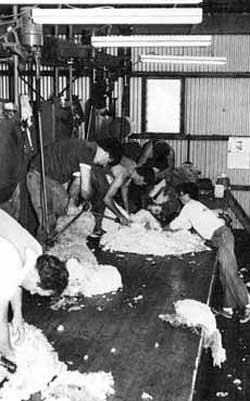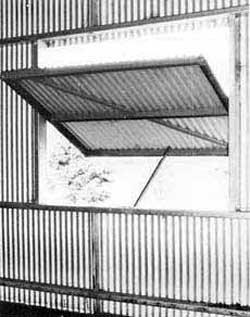
Shearing shed design - lighting and ventilation
Introduction
The shearing shed should be a pleasant place for all who work in it. Good lighting and ventilation improve working conditions and efficiency, and are not always costly to upgrade in existing sheds. Both location and aspect will influence the amount of light and ventilation available in a shed.
Light
The performance of almost every task in the shed is affected by the available light, one of the most important considerations in shearing shed design. Good light is essential for quality shearing, woolclassing and other shed activities, and is a most significant factor affecting sheep flow in the penning area.
Light sources can be either natural or artificial, and both the quantity of light and the uniformity of its distribution are important.
Natural light
Good shearing shed design makes maximum use of natural lighting. Indirect or diffuse light is best. Direct sunlight should not be used as natural light for the board and wool room because the glare from newly shorn wool causes eye strain for shearers and wool handlers. Southern walls can be used as a source of natural lighting because direct sunlight is never a problem.
Materials are available to diffuse direct sunlight entering the shed—for example, translucent sheeting panels can be fitted into the roof of the shed. The simplicity with which these panels can be fitted makes raising the lighting level, particularly in the sheep storage area, a quick and relatively low cost operation. However, in the pastoral areas of western New South Wales, roof panels may direct too much heat into the shearing shed.
Translucent sheeting can also be used as wall cladding and provides excellent natural light when installed along the southern wall of the shed just below the roof level. Wall shutters and louvres can also be installed in the sides of the shed to supplement other sources of light.
In brief:
- Southern walls can be used for natural shed lighting. Although light-diffusing materials can be used, they are not necessary because direct sunlight will not be a problem.
- Northern walls generally require the installation of light-diffusing materials to avoid glare from direct sunlight on shorn wool.
- Eastern and western walls can be clad with translucent sheeting to provide diffuse natural light.
- If 5 per cent to 10 per cent of the roof area is to be used to raise the lighting level inside the shed, use only roof panels that throw diffuse lighting. These roof panels are best located over the sheep-holding and wool storage areas.
- Where sheep are shorn or crutched in summer, translucent or light-diffusing material can increase the temperature inside the shed.
- Large, hopper-type windows are an excellent low-cost source of natural light and ventilation (see Figure 2).
Artificial light

Artificial light is installed to overcome variation in both quality and quantity of natural light during the day and for night-time activities such as shedding sheep and pressing wool.
Fluorescent lights are recommended, their advantages being:
- economical operation and maintenance;
- colour rendering can be chosen to match natural daylight so as to allow correct assessment of wool colour.
To illuminate the shearing area, fluorescent lights hung parallel to the board, about 1.5 m away from the shearers towards the wool room, will reduce shadows on the sheep during shearing.
Recommended illumination levels are 500 lux for the classing table and 250 lux for the shearing board. A level of 100 to 200 lux is adequate for the sheep storage area and wool room.
These levels can be obtained as follows:
- 500 lux—two twin-tube 40 W industrial fittings mounted 1500 mm above the surface of the wool table;
- 250 lux—single twin-tube 40 W industrial fitting mounted 2200 mm above the board and 700 mm forward of the shearer’s normal working position.
For wool classing purposes, tubes with appropriate colour correction are needed for true identification of colour in the wool. Tubes with descriptions of 36 W colour 86 Triphosphor Daylight are satisfactory.
Before each shearing, dust the tubes or wipe them clean. Since tubes deteriorate in performance with age, they should be replaced every 10 years. Use the same size tube throughout the shed so that they are interchangeable.
Globe-type lights are only suitable for use under a shearing shed. Floodlights can be installed to illuminate the shed entrance ramp and yards as an aid to shedding sheep at night.
Painting
Light pastel colours are recommended for painting the inside of a shearing shed. These colours improve the efficiency of available light because they reflect 60–70 per cent of the incident light, improving working conditions in the shed. However, for the interior of a shearing shed, it is usually only practical to paint only the surface of the board wall facing the board.
Ventilation
Good ventilation is essential to provide fresh air and improve working conditions during hot weather. Adequate ventilation will also reduce condensation, particularly when a ridge vent is used. The amount of ventilation required will vary with the location of the property and the weather conditions expected during shearing and crutching.
The location and size of the sheep entrance and the woolroom door contribute to good ventilation. These can be supplemented by hopper windows (see Figure 2) that provide natural light and allow air movement to be controlled.

Traditional louvre windows can be installed to provide both natural light and controlled ventilation.
A number of built-in features can be installed in a shearing shed to improve ventilation. These include open extended eaves and ridge vents which allow warm, moisture-laden air to escape, giving some control over condensation as well as contributing to better working conditions. However, these features do not allow any control over the amount of air movement, and open eaves may not be appropriate in a cooler climate where wall shutters may be preferable.
Shed temperature
The internal temperature of a shearing shed can be influenced by the selection of roofing material. Aluminium roofing, or aluminium foil-type insulation under corrugated iron roofing can lessen extreme temperatures in sheds where sheep are shorn in summer. Both aluminium roofing and aluminium foil insulation offer the added advantage of preventing condensed moisture dripping from the roof onto sheep.
If aluminium foil is used, a secure chicken wire covering is necessary to prevent damage to the foil by nesting birds.
The quality of the ventilation system installed in the shed will also influence the internal temperature within the shearing shed.
Further information
- Shearing shed design—sheep storage and movement (Agfact A3.E.1)
- Shearing shed design—the board (Agfact A3.E.2)
- Shearing shed design—the wool room (Agfact A3.E.3)
Acknowledgment
This Agfact was adapted in part from the Australian Wool Corporation publication Wool Harvesting Notes.

